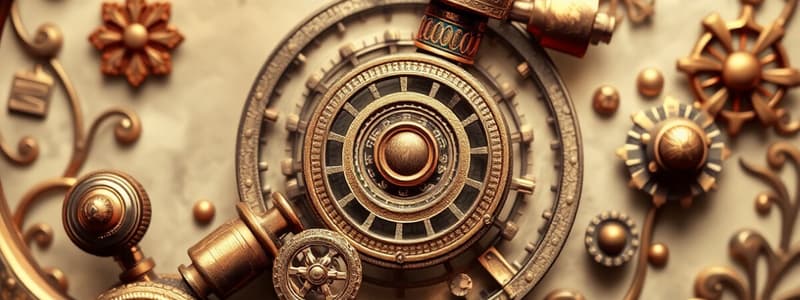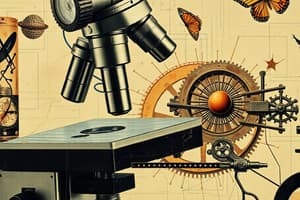Podcast
Questions and Answers
What is the primary purpose of a microscope?
What is the primary purpose of a microscope?
- To support the slide in place
- To magnify objects that are too small to be seen by the naked eye (correct)
- To illuminate specimens
- To hold the mirror
What does the coarse adjustment screw do?
What does the coarse adjustment screw do?
It is used to adjust the low power objective in focusing.
What structure supports the microscope?
What structure supports the microscope?
Base
What is the function of the iris diaphragm?
What is the function of the iris diaphragm?
Which part is used to hold the slide in place?
Which part is used to hold the slide in place?
The Abbe condenser is used to spread light across the specimen.
The Abbe condenser is used to spread light across the specimen.
What is total magnification?
What is total magnification?
Never allow water and chemicals to come in contact with the _____ or metallic parts.
Never allow water and chemicals to come in contact with the _____ or metallic parts.
What is the function of the fine adjustment screw?
What is the function of the fine adjustment screw?
What should you do if you have difficulty focusing the microscope?
What should you do if you have difficulty focusing the microscope?
Flashcards are hidden until you start studying
Study Notes
Microscope Overview
- A microscope is an instrument designed to magnify small objects not visible to the naked eye.
Mechanical Parts
- Adjustment Screws: Two pairs of wheels on the body tube; coarse adjustment for low power focus, fine adjustment for delicate focus on high power and oil immersion.
- Base: Y or U-shaped support structure for the microscope.
- Draw Tube: Upper end of the body tube housing the eyepiece or ocular lens.
- Body Tube: Vertical cylindrical part that contains the dust shield and nosepiece with objectives.
- Handle/Arm: Curved metal part for holding the microscope.
- Dust Shield: Protects the objectives' lenses from dust.
- Revolving Nosepiece: Holds and rotates the objective lenses for selection.
- Stage: Flat platform for placing slides.
- Stage Clips: Structures that secure slides in place on the stage.
- Inclination Joint: Allows tilting of the microscope.
- Pillar: Metal segment supporting the microscope, attached to the base.
- Mirror Rack: Holds the mirror used for directing light towards the specimen.
Magnifying Parts
- Ocular/Eyepiece: Lens at the draw tube for viewing specimens.
- Objectives: Primary magnifying lenses of varying powers:
- Scanner (4x) for a whole view.
- Low Power (10x) for a larger image.
- High Power (40x) for detailed views.
- Oil Immersion (100x) for maximum magnification, requiring immersion oil.
- Total Magnification: Calculated as Objective Power x Eyepiece Power.
Illuminating Parts
- Abbe Condenser: Concentrates light onto the specimen.
- Iris Diaphragm: Adjusts light amount using circular blades.
- Mirror: Directs light with concave and flat surfaces, enhancing visibility.
Maintenance and Care
- Always carry with both hands: one on the handle, one on the base.
- Avoid contact between water/chemicals and the microscope components.
- Clean lenses with tissue or soft paper.
- Store away from the edge of the table, never in a tilted position.
- Seek instructor assistance for any focusing issues.
How to Use the Microscope
- Set up the microscope carefully.
- Clean the lens before viewing.
- Prepare and insert the slide appropriately.
- Adjust light control for optimal clarity.
- Focus the microscope, starting with low power.
- Gradually increase magnification for detailed observation.
Terminologies
- Field of Vision: Circular area viewed through the ocular where the specimen appears.
- Magnifying Power: The lens's ability to enlarge images.
- Magnification: Ratio of the image's apparent size to the specimen's actual size.
- Total Magnification: Product of eyepiece and objective magnifying power.
- Numerical Aperture: Indicates the light-gathering capability of the lens.
- Resolution: Finest detail visible in the image; smaller pixel size equates to finer detail.
- Resolving Power: Lens’s ability to distinguish between two points or lines clearly.
Studying That Suits You
Use AI to generate personalized quizzes and flashcards to suit your learning preferences.




